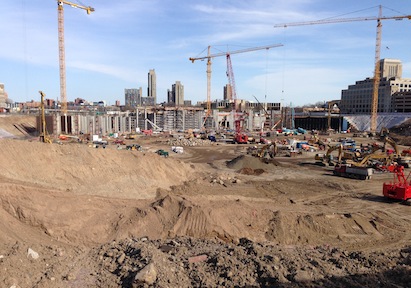Due to the weather-related slow start in the nonresidential building market during the first part of the year, and the prolonged weakness in the institutional sector, construction spending projections for the rest of the year have been lowered slightly.
The commercial construction sector is still looking at solid spending increases throughout the remainder of 2014, paced by high levels of demand for hotels and office buildings. The American Institute of Architects’ (AIA) semi-annual Consensus Construction Forecast, a survey of the nation’s leading construction forecasters, is projecting that spending will see a 4.9% increase in 2014 – down from the previous estimate of 5.8%, with next year’s projection holding at 8%.
VIDEO: AIA Chief Economist discusses economic trends for 3rd quarter of 2014
“The institutional market has been a drag on the overall recovery for the design and construction industry for the last few years, and until we see state and local governments ramp up spending for new education, healthcare and public safety structures there likely won’t be a widespread acceleration in spending for the entire industry,” said AIA Chief Economist, Kermit Baker, PhD, Hon. AIA. “But we continue to have an optimistic outlook for the commercial and industrial sectors both for the rest of this year and into 2015.”
|
Market Segment Consensus Growth Forecasts |
2014 |
2015 |
|
|
|
|
|
Overall nonresidential building |
4.9% |
8.0% |
|
|
|
|
|
Commercial / industrial |
9.9% |
11.2% |
|
Hotels |
14.5% |
9.2% |
|
Office buildings |
12.8% |
13.3% |
|
Industrial facilities |
7.6% |
9.2% |
|
Retail |
7.4% |
10.4% |
|
|
|
|
|
Institutional |
-0.1% |
5.8% |
|
Amusement / recreation |
3.7% |
6.6% |
|
Education |
-0.1% |
5.7% |
|
Healthcare facilities |
-1.8% |
6.6% |
|
Religious |
-4.1% |
0.7% |
|
Public safety |
-4.2% |
3.3% |
Baker continued, “While there does not appear to be any structural frailties in the overall economy that could possibly derail increasing levels of construction spending over the next 18 months, lending standards at financial institutions continue to fall well short of the increasing demand for commercial real estate loans, which is another factor that serves as a wild card and a source of concern for the entire industry.”
About the AIA Consensus Construction Forecast Panel
The AIA Consensus Construction Forecast Panel is conducted twice a year with the leading nonresidential construction forecasters in the United States including, McGraw Hill Construction, Wells Fargo Securities, IHS-Global Insight, Moody’s economy.com, Reed Business Information, Associated Builders & Contractors and FMI. The purpose of the Consensus Construction Forecast Panel is to project business conditions in the construction industry over the coming 12 to 18 months. The Consensus Construction Forecast Panel has been conducted for 15 years.
About The American Institute of Architects
Founded in 1857, members of the American Institute of Architects consistently work to create more valuable, healthy, secure, and sustainable buildings, neighborhoods, and communities. Through nearly 300 state and local chapters, the AIA advocates for public policies that promote economic vitality and public well being. Members adhere to a code of ethics and conduct to ensure the highest professional standards. The AIA provides members with tools and resources to assist them in their careers and business as well as engaging civic and government leaders, and the public to find solutions to pressing issues facing our communities, institutions, nation and world. Visit www.aia.org.
Related Stories
| Aug 11, 2010
Great Solutions: Healthcare
11. Operating Room-Integrated MRI will Help Neurosurgeons Get it Right the First Time A major limitation of traditional brain cancer surgery is the lack of scanning capability in the operating room. Neurosurgeons do their best to visually identify and remove the cancerous tissue, but only an MRI scan will confirm if the operation was a complete success or not.
| Aug 11, 2010
Great Solutions: Collaboration
9. HOK Takes Videoconferencing to A New Level with its Advanced Collaboration Rooms To help foster collaboration among its 2,212 employees while cutting travel time, expenses, and carbon emissions traveling between its 24 office locations, HOK is fitting out its major offices with prototype videoconferencing rooms that are like no other in the U.
| Aug 11, 2010
2009 Judging Panel
A Matthew H. Johnson, PE Associate Principal Simpson Gumpertz & HegerWaltham, Mass. B K. Nam Shiu, SE, PEVP Walker Restoration Consultants Elgin, Ill. C David P. Callan, PE, CEM, LEED APSVPEnvironmental Systems DesignChicago D Ken Osmun, PA, DBIA, LEED AP Group President, ConstructionWight & Company Darien, Ill.
| Aug 11, 2010
Inspiring Offices: Office Design That Drives Creativity
Office design has always been linked to productivity—how many workers can be reasonably squeezed into a given space—but why isn’t it more frequently linked to creativity? “In general, I don’t think enough people link the design of space to business outcome,” says Janice Linster, partner with the Minneapolis design firm Studio Hive.
| Aug 11, 2010
BIM school, green school: California's newest high-performance school
Nestled deep in the Napa Valley, the city of American Canyon is one of a number of new communities in Northern California that have experienced tremendous growth in the last five years. Located 42 miles northeast of San Francisco, American Canyon had a population of just over 9,000 in 2000; by 2008, that figure stood at 15,276, with 28% of the population under age 18.







